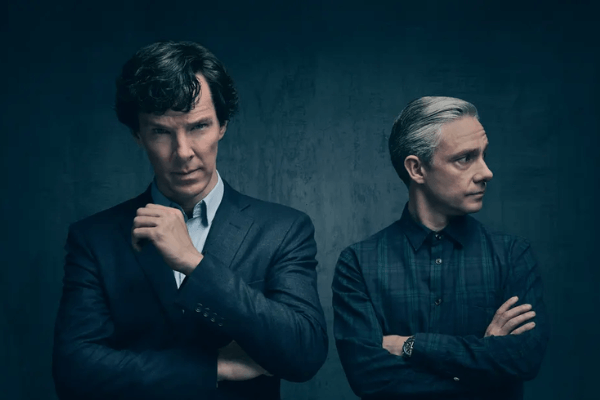Last Updated on March, 2023 by Edison
Learning how to read people can be a game-changer in both your personal and professional life.
And you don’t need to be a highly trained police officer or a psychologist to do it.
I’ve compiled an extensive list of ways to read body language, based on insights from psychology books and real-world experience.
In this in-depth guide you will learn to:
- Understand the body language of hands and the hidden messages they convey
- Identify different types of smiles and their meaning
- Recognize the subtle signals of stress, anxiety, or lying
- Become more confident in interacting with others
And much more…
Types of arm crossing and their meaning
Crossed arms on the chest have a negative or defensive meaning.

You can observe it in public meetings, hospitals, and elevators – where people feel uncomfortable.
What about people who are conversing with you?
When someone takes the arm-crossed position, you may have said something with which they disagree. Continuing your argument may be pointless even though they verbally agree with you.
The fact is that body language is more honest than words.
Reinforced arm crossing – When someone has clenched fists and a full arm crossing, he feels threatened or defensive. It may be accompanied by a tight-lipped smile, a snarl, or even squinty eyes.
Another detail you may notice is the red face and clenched jaws.
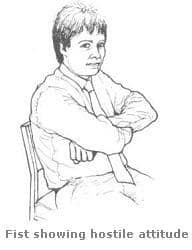
Try to defuse the situation when someone is sitting like that because they are not having a good time.
Arm gripping shows someone feeling weak or exposed and trying to reinforce their mind by grabbing the biceps.
Another detail you may notice is that their knuckles may turn white.
With reinforced arm crossing, he was trying to protect himself. But, with the arm gripping, he is trying to make himself feel better.

Hugging Yourself is a partial arm cross where one arm passes across the body to hold or touch the other.
It looks as if he/she is hugging himself and shows a lack of self-confidence.

The body language of the hands
Palm displays are a sign of honesty and positively affect people.
It communicates acceptance, openness, and trustworthiness.
When someone begins to open up or be truthful, they will likely expose their palms.
It is an unconscious gesture, and it will give you an intuitive feeling that she is telling the truth.

Palms down are used to project direct authority. It also shows confidence and that you know what you are talking about.

Chopping gestures show that you have made up your mind and are not likely to change it.
If you use this gesture, don’t be too aggressive.

Placing your hand in the heart means “I want you to believe me”, even when you are not telling the truth.
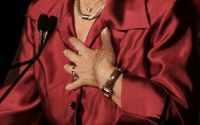
Hands behind the back show confidence because the front body and vital organs are exposed.

Pacifying behaviors
When stressed, we unconsciously do some little movements to be comfortable again.
– Covering the neck dimple pacifies insecurities, emotional discomfort, or fear.
Playing with a necklace often serves the same purpose.

– Rubbing the forehead signals he is undergoing slight to severe discomfort.

– Exhaling with puffed-out cheeks is a great way to release stress.

– Cheek or face touching is a way to soothe when nervous, irritated, or concerned.
Men prefer to touch their faces, while women prefer to touch their necks, clothing, or jewelry.
– Men tend to massage the neck to soothe distress. This area is rich with nerves, including the vagus nerve, which, when rubbed, will slow down the heart rate. Even a brief touch of the neck will ease anxiety or discomfort.
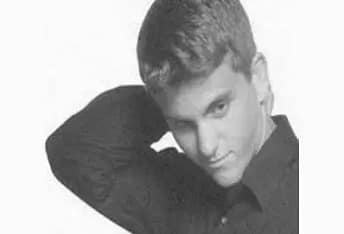
– When stressed, some people place their hands on their legs and then slide them down toward the knee.
This pacifying behavior often goes unnoticed because it frequently occurs under a desk or a table.
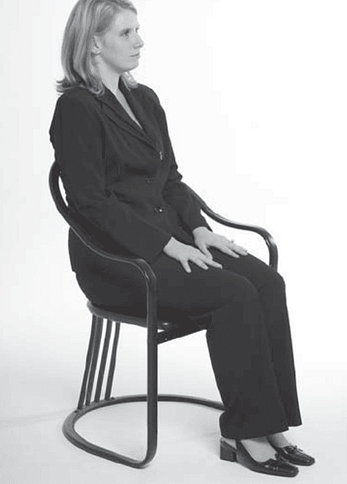
Types of handshakes and their meaning
These handshakes are common in social encounters and can give you important information about people you meet.
Dominant handshake – Turning your hand so that his palm faces down shows dominance. It communicates that you want to take control of the encounter.
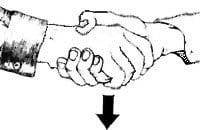
The submissive handshake – Offering your hand with your palm facing upward gives the message that you are giving control.
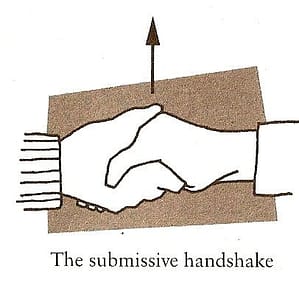
An equal handshake is when both palms are in the vertical position. It creates a feeling of equality and mutual respect.
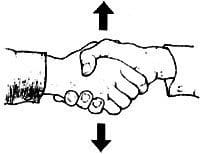
Double Handshake is accompanied by a smile, direct eye contact, and saying their name.
It gives the impression that you are trustworthy and honest.
But don’t use it with strangers. The double handshake is like a mini hug and is acceptable only when a hug is acceptable.

Types of smiles and their meaning
The tight-lipped smile
People use this fake smile to be polite.
It might also send the message that she has a secret or keeping an opinion that she won’t share with you.

The twisted smile is a kind of grin. It sends the message that what you say is nonsense.

The dropped-jaw smile is when the lower jaw is dropped down. It gives the impression that the person is playful. It is a fake smile, but in a photograph gives a sense of joy and cheerfulness.

Sideways looking up – With the head slightly lowered while looking up with a tight-lipped smile. It makes people look playful and secretive.

A grin or smirk shows smugness and arrogance. It is a tight-lipped smile with the addition of a degree of self-satisfaction.
Along with this smile, you may see the dominant body language, such as pulling your head and shoulders back.
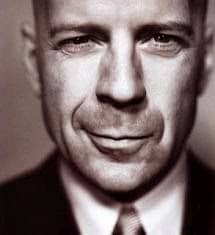
Confident body language
Your body language has a two-way connection with the brain.
First, it reflects your thoughts and feelings.
Second, it influences the messages your brain gets from the environment.
So simply adopting a confident body language can help you feel more confident in social situations.

Here are some quick tips that will help you feel more confident.
– Look people in the eye most of the time. It gives the impression that you are truthful and approachable and makes people feel good around you.
If you feel uncomfortable, you can look at their eyebrows and gradually move to full eye contact.
– Keep your palms open because it subconsciously shows people you have nothing to hide.
– Don’t keep your hands in your pocket.
Instead, relax your hands at your sides, and use them to illustrate your words.
– When you meet someone, you should be the one who initiates the handshake or a hug. Give a neutral handshake, smile, and maintain eye contact.
– Stop fidgeting because it gives the message that you are feeling anxious.
– Exercise regularly to strengthen your back muscles so you can sit straight.
– Eliminate filler words such as: “Uhh”, “Um”, “like”, “I mean”, “You know”, and “Ok, so”. It shows that you lack confidence in what you are saying.
Walk with confidence
Walking confidently will help you maintain a correct posture, grab attention from others and feel better about yourself.
How to walk down the street that makes people think: “He is confident”.
1. Do not look down. It shows that you are feeling bad or that you have low self-esteem.
2. Pull your shoulders back. If you look down and walk with your shoulder in front, you’ll seem bored or in a bad mood even if you aren’t.
However, you’ll look great if you pull your shoulders back.
3. Let your arms move with your body.
4. Let the upper torso and your shoulders move slightly as you move.
At first, you will move in an exaggerated way, but as you practice, it will become more natural.
5. You may have noticed that confident people walk more slowly than others, whether in movies or real life. It gives the impression that they’re in control and important.
Common lying gestures
When people are lying, they might make some unconscious gestures.
The mouth cover – The brain unconsciously instructs the hand to cover the mouth to suppress deceitful words. Some people try to disguise the mouth cover by giving a fake cough.
The nose touch – Sometimes, the nose touch can be quick below the nose.
Scientist shows that when you lie, chemicals known as catecholamines are released. This causes tissue inside the nose to swell.
They found that the nose expands blood flow during lying, known as the “Pinocchio effect.”
The eye rub – The brain attempts to block out deceit or doubt.
Women are less likely to use eye rub because of makeup. Instead, they will use small gentle touching motions below the eye.
The ear rub – It includes rubbing the back of the ear. It also can be a sign that the person has heard enough or may want to speak.
The neck scratch – When the index finger scratches the side of the neck below the earlobe.
It’s a gesture of doubt or uncertainty. It is characteristic of the person who says
It is
For example, when the person says, “I can understand how you feel, ” but the neck scratch indicates they don’t.
The collar pull – Lie causes a tingling sensation in the facial and neck tissues, and a rub or scratch is required to please it.
Increased blood pressure from the lie causes sweat to form on the neck. When the deceiver feels that you suspect he is not telling the truth.
It also occurs when a person feels angry or frustrated and needs to pull the collar away from his neck to let the fresh air circulate.
7 Basic Emotions
Some people may be more skilled at manipulating their facial muscles than others, but no one can control the face entirely.
Brain areas like the amygdala and prefrontal cortex process emotions, making them challenging to control.
When we feel an emotion, our brain sends a message to our face so that we can show that feeling.
The process happens so fast that often our facial expressions show what we feel even before we’re conscious of the feeling.
I have learned a psychological trick to understand what someone is truly feeling. Ask a direct question and pay close attention to their face.
Surprise them by asking a direct question, then pay attention to their immediate reaction.
For the first three seconds, they can’t mask their genuine feelings. And they will give themselves away.
But, after three seconds have passed, they have regained their composure. And they’ll give misleading facial expressions to hide their real thoughts.
#1 Fear – When we feel fear, our eyebrows shoot up, and our eyes are more open. Our jaw drops open, lips stretch horizontally, and we pull our chin back.

#2 Sadness – Corners of our lips pull down, we raise our cheeks in a near squint, and our upper eyelids droop. Some researchers say that a sad face is the lower intensity version of a crying face.

#3 Happiness – We show happiness with a genuine smile, where both checks are in symmetry. It causes involuntary movements of the muscles around the eyes and narrowed eyelids.

#4 Surprise – Our eyebrows rise, eyelids widen, and our mouth drops down.

#5 Anger –Eyebrows down, lips narrowed and pulled in tight.

#6 Contempt – Asymmetric face, one lip corner pulled back and in.
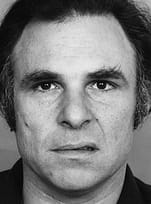
#7 Disgust – We show disgust by scrunching up our nose and raising our cheeks and upper lip.

Verbal leaks
Another great way to find out if someone is lying is by paying attention to how they talk.

Slips of the tongue – It is a mistake when someone is talking and uses a different word.
In January 2003, the bodies of Laci Peterson and her unborn son were found on the shore of San Francisco Bay.
Two months before, Diane Sawyer interviewed Lacis’s husband, Scott, on Good Morning America.
Sawyer asked Scott, “What kind of marriage was it?” He replied, “God, it was glorious. We took care of each other. She was amazing. She is amazing.”
His use of past tense suggests that he already knew she was dead.
In November 2004, he was convicted of the murder of his wife.
Specific Denials – People who are telling the truth offer categorical denials of doing something wrong.
“I’ve been in business for thirty years, and I’ve never cheated anyone. We don’t do backroom deals, and we don’t intend to start now.”
Liars often prefer to be much more specific: “I did not try to cheat you,” “We are not negotiating with United Motors.”
Unskillfulness in speaking – During our communication we make sounds, sighs, and pauses that color and interrupt our normal talking.
When people know what to say and are confident about it, they express themselves straightforwardly.
“I came home last night around ten-thirty.”
“No, I’ve never met her before.”
“What do you want to know?”
People who are stressed out try to slow down and gain more time to think about what they will say.
They try to fill the pauses with sound.
“Uh, I came home last night around ten-thirty.”
“No”—short laugh—“I’ve never met her before.”
The speaker clears her throat. “What do you want to know?”
Questioning someone might make him nervous and talk suspiciously even if he didn’t do anything wrong.
Not using the pronouns – Pronouns give us responsibility, and we tend not to use them when we are lying.
“Got up this morning. Went out for a run, then took a shower and changed. Got to work and went straight to the meeting.
Another way someone might distance himself through language is by replacing the pronoun I with you.
“You just don’t cheat”
When couples start to look alike
Couples who have a long, happy marriage often will look alike.
It is because they are continually mirroring each other’s facial expressions. Eventually, they will build muscle patterns in the same areas of the face.
Couples who don’t look similar can appear similar in a photograph because they use the same smile.

In addition, according to psychologist John Gottman, marriages are more likely to fail when partners mirror the expressions of contempt.
Contempt behavior affects the smiling partner even when unaware of what is happening.
So couples need to mirror expressions of happiness. It is a reliable indicator that the marriage will last for years.
How to spot a fake smile
Many people use fake smiles during a job interview, with a group of friends, or on a date.
Some use it to seem more engaging, to camouflage real feelings, or when they are lying.
Now, two sets of muscles control the smiles:
Orbicularis oculi muscles pull the eyes back.
The zygomaticus major pulls the mouth back to expose the teeth and enlarge the cheeks
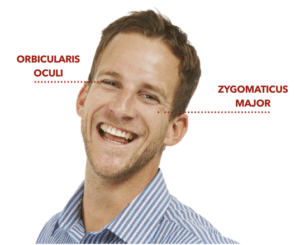
You can control the zygomatic muscles quickly and consciously. And that’s how you produce a fake smile.
But genuine smiles are automatic. When you feel happy, signals pass through the part of the brain that processes emotion. It will make your mouth muscles move, your cheeks raise, and your eyebrows dip slightly. And both sides of your face are engaged.
On the other hand, a false smile often appears stronger on one side of the face than the other.
And we tend to show both teeth – the same as when you say cheese when you take a picture
But this is not 100% accurate because some people have large mouths and may expose both teeth even with a genuine smile.
What shows extended blinking
Extended blinking is an unconscious attempt to block you from their sight.
They may have become bored or disinterested or feel superior to you.
It is as if their brain can no longer tolerate dealing with you. So their eyes shut for two or three seconds to wipe you from sight and remain closed as the person momentarily removes you from his mind.
Understanding yourself and others
In the video below, I go deeper into understanding people based on the teachings of Freud. You will learn key insights about human personality in less than 12 minutes.

